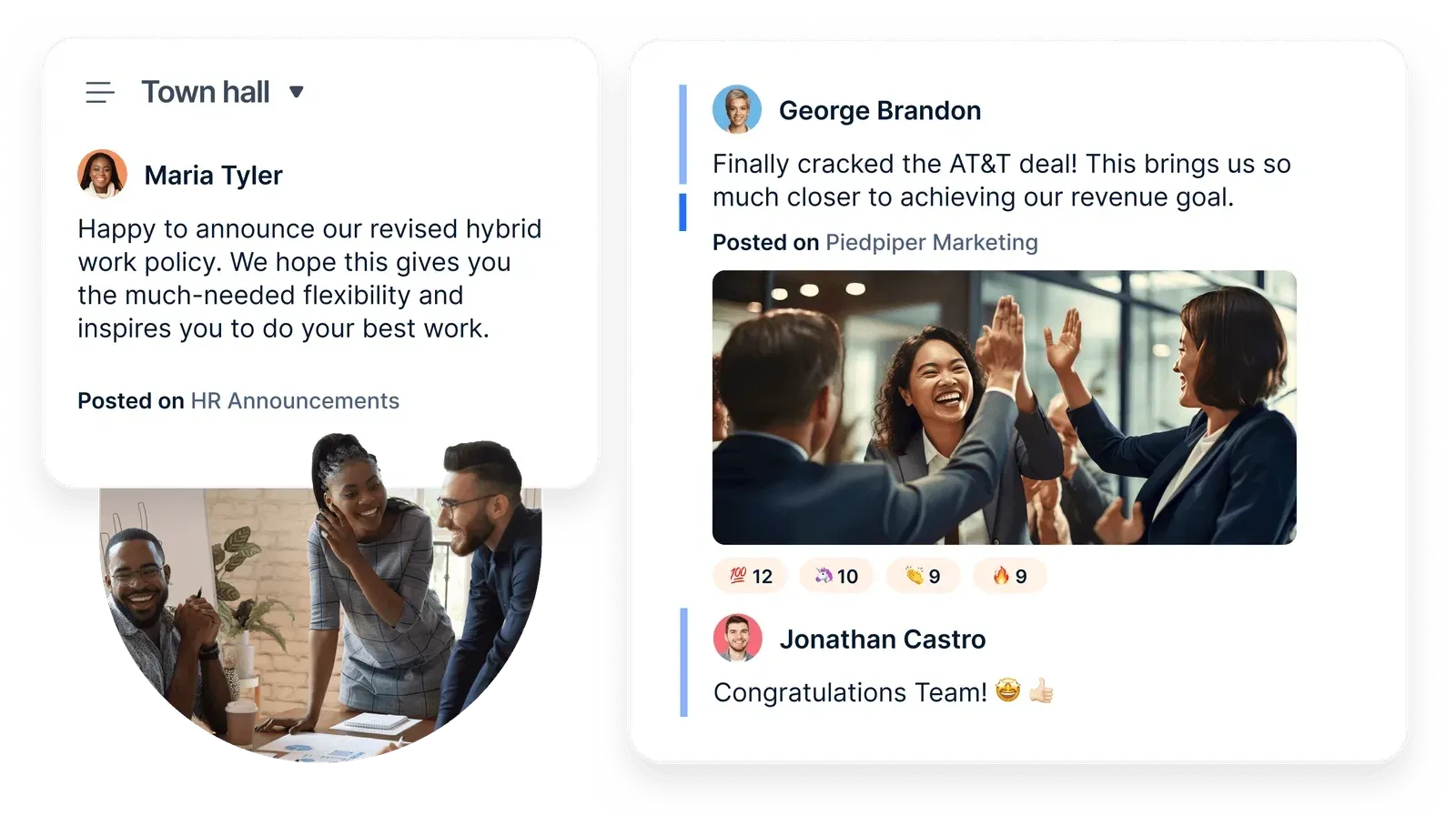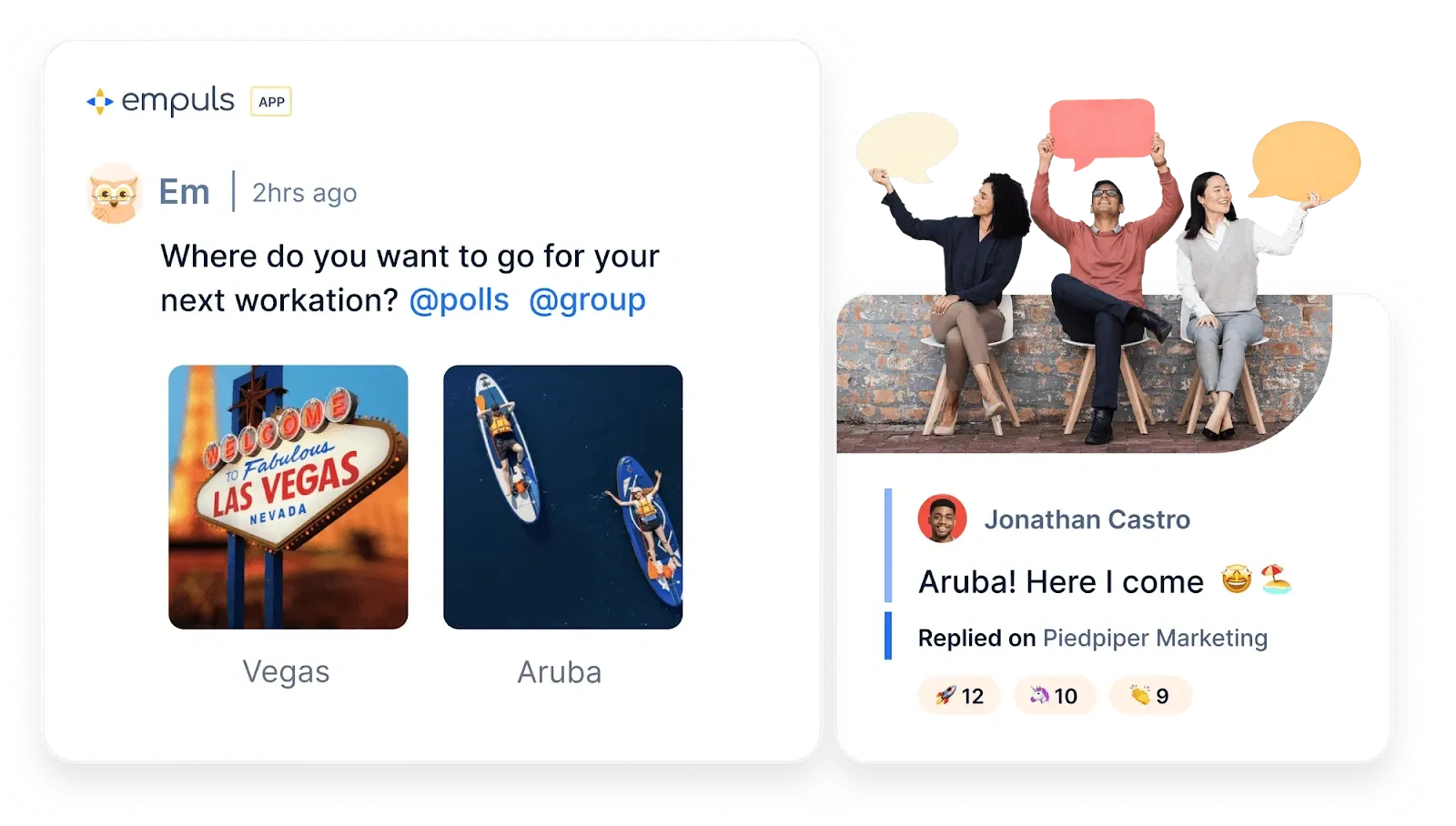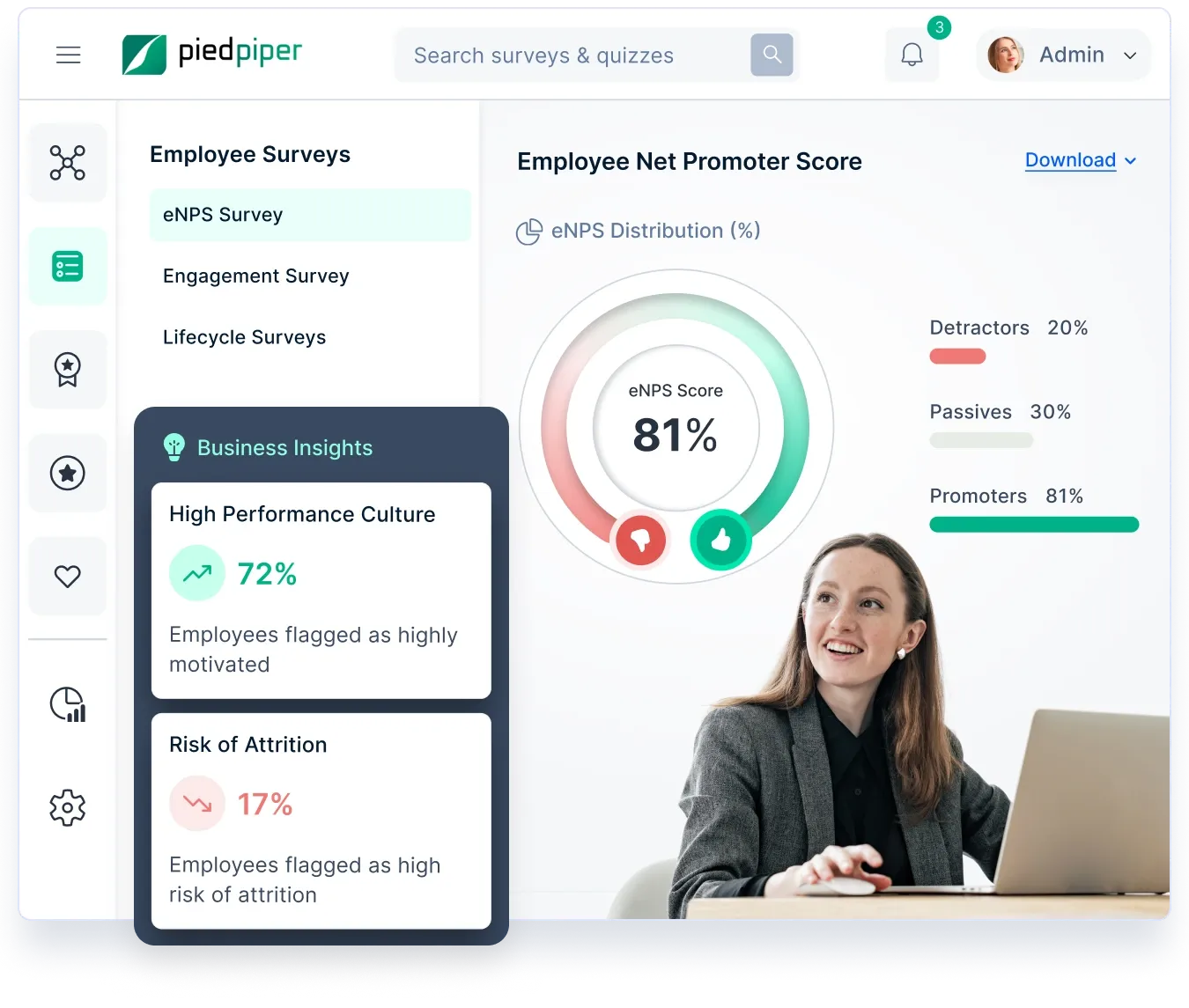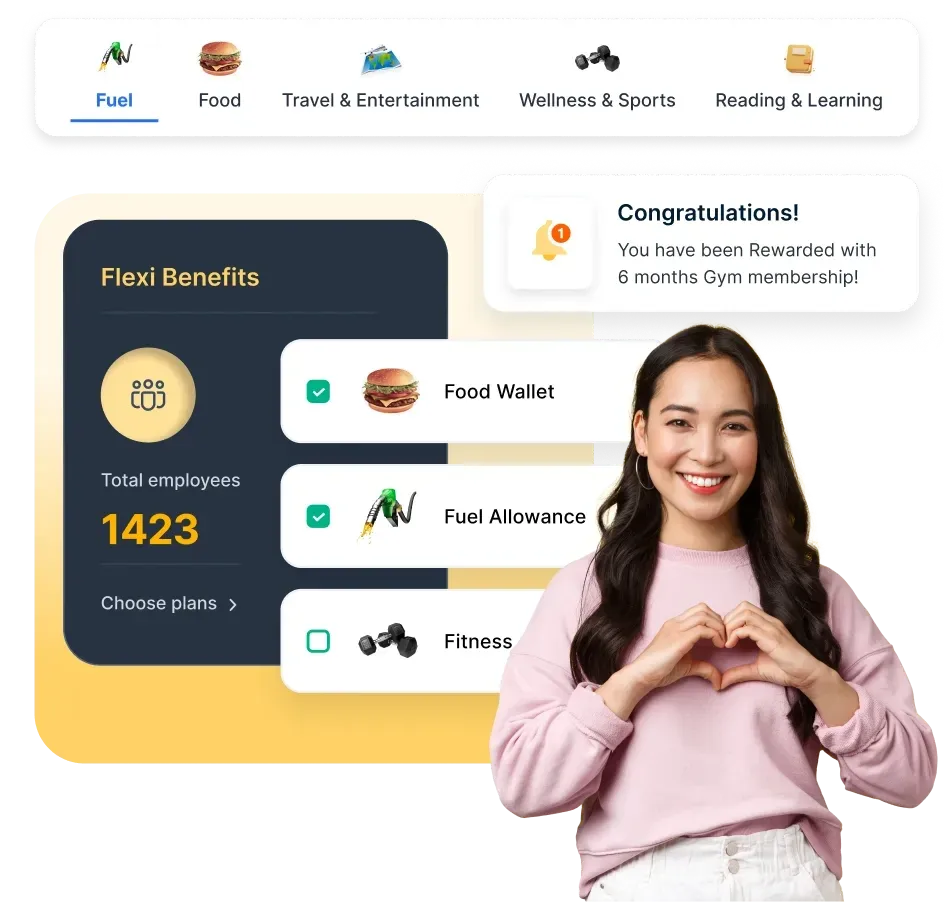Employee Connection & Networking Ideas for a Collaborative Workplace
Strong employee connection fosters teamwork, engagement, and workplace satisfaction. Explore effective employee networking ideas that encourage collaboration, strengthen relationships, and create a more connected workforce.
On this page
- What is employee connection?
- Why employee connection matters more than you think
- The three pillars of employee connection
- The link between employee engagement and employee connection
- 15 strategies to boost employee connection
- Strengthening employee connection with Empuls
- Empuls helped Prodevans Technologies to reinvent employee engagement for distributed teams
- Conclusion
A workplace isn’t just a collection of desks and deadlines—it’s a network of people, ideas, and relationships. Employee connection is the foundation of a thriving work environment, where collaboration isn’t forced but happens naturally.
When employees feel truly connected, they communicate better, solve problems faster, and bring more energy to their work.
But connecting with employees goes beyond casual chats or team lunches. It’s about fostering meaningful interactions that make employees feel valued, heard, and part of something bigger than their to-do lists. Organizations that prioritize employee networking ideas create a culture where collaboration, trust, and engagement flourish.
So, how to improve connection in the workplace? It starts with intentional strategies—from structured networking activities to open communication platforms that bring employees together. This article explores the best ways to build strong workplace relationships, ensuring employees aren’t just working side by side but truly working together.
What is employee connection?
Employee connection refers to the sense of belonging, engagement, and collaboration among employees within an organization. It’s about building strong relationships, fostering teamwork, and creating an environment where employees feel valued and connected to their colleagues, leadership, and company culture.
A well-connected workforce leads to higher engagement, better communication, and increased productivity. Employees who feel genuinely connected are more likely to collaborate effectively, stay motivated, and contribute positively to the organization.
Key aspects of employee connection include:
- Workplace relationships: Encouraging meaningful interactions between employees and teams.
- Company culture alignment: Helping employees feel a part of the organization’s mission and values.
- Cross-team collaboration: Breaking down silos and promoting teamwork across departments.
- Engagement and retention: Keeping employees motivated, valued, and committed to their roles.
Organizations can strengthen employee connection by fostering open communication, implementing employee networking ideas, and providing opportunities for collaboration and recognition.
Why employee connection matters more than you think
Picture a workplace where employees show up, do their tasks, and leave—zero camaraderie, no real conversations, just a transactional exchange of effort for a paycheck. That’s what a disconnected workplace looks like, and it’s a silent productivity killer.
Now, flip the script. Imagine a team where people genuinely connect—where discussions aren’t just about deadlines but about ideas, challenges, and growth. That’s the difference employee connection makes. It’s not just about team bonding; it’s the foundation of innovation, collaboration, and long-term success.
When employees feel connected, they don’t just work together—they think together. Ideas flow, feedback loops tighten, and a culture of trust takes shape. That’s when employees stop working for a company and start working with it.
The impact? Engagement levels rise, decision-making sharpens, and retention stops being a game of chasing higher salaries. People stay where they feel heard, valued, and part of something bigger than their job descriptions.
Why does employee connection matter?
- Stronger collaboration: When teams communicate well, projects move faster, and ideas turn into action.
- Higher engagement: Connected employees don’t just do their jobs—they take ownership and drive impact.
- Better knowledge sharing: Insights aren’t stuck in silos; they move freely across teams, improving problem-solving.
- Increased retention: People don’t leave environments where they feel valued, supported, and challenged.
- More innovation: A connected workforce is a thinking workforce. The best ideas often come from casual, unscripted interactions.
Employee connection isn’t a soft skill—it’s a business asset. Companies that get this right don’t just build teams; they build ecosystems where people thrive, and performance follows.
The three pillars of employee connection
A strong employee connection isn’t just about social interactions—it’s about how employees relate to their colleagues, their work, and the company culture. When all three elements align, organizations create an engaged, motivated, and high-performing workforce.
1. Employee connection to people
Workplace relationships shape the way employees feel about their jobs. Meaningful connections with colleagues, managers, and leadership foster trust, collaboration, and a sense of belonging. Employees who feel valued by their peers and leaders are more likely to be engaged, communicative, and invested in the team’s success.
How to strengthen it:
- Encourage networking opportunities through cross-team projects and mentorship programs
- Foster peer recognition to make employees feel seen and appreciated
- Use platforms like Empuls’ social intranet to enable real-time collaboration and discussions
2. Employee connection to the work
Employees who feel a direct link between their efforts and company success are more engaged and motivated. When work is meaningful and aligned with personal strengths, employees don’t just complete tasks—they take ownership, innovate, and drive results.
How to strengthen it:
- Set clear goals that tie individual work to the company’s bigger picture
- Provide learning rewards through platforms like Empuls milestone rewards to motivate skill-building
- Offer continuous feedback so employees understand their impact and areas for growth
3. Employee connection to the culture
Company culture shapes how employees experience their workplace. A strong, inclusive, and purpose-driven culture ensures employees feel like they belong—not just as workers, but as integral parts of the organization’s mission.
How to strengthen it:
- Reinforce company values through consistent communication and leadership actions
- Use Empuls surveys to gather feedback and ensure cultural alignment
- Offer perks and benefits that reflect company priorities, such as wellness programs and flexible work options
When employees feel connected to people, work, and culture, engagement becomes effortless. A well-connected workforce isn’t just productive—it’s unstoppable.
The link between employee engagement and employee connection
Employee engagement and employee connection are two sides of the same coin—one fuels the other. Engagement is about how committed and motivated employees feel toward their work, while connection is about how deeply they relate to their colleagues, leaders, and company culture. When employees feel connected, engagement becomes a natural outcome.
Think of it this way: Engagement thrives when employees feel seen, heard, and valued—and that only happens when there’s a strong sense of connection. A disconnected employee might be highly skilled but disengaged, working in isolation without enthusiasm or purpose.
On the other hand, an engaged employee actively contributes, collaborates, and stays invested in both their personal growth and the company’s success.
- Stronger relationships lead to higher motivation.
Employees who form real connections with their teams and leaders are more likely to be engaged, as they feel like part of a larger mission rather than just filling a role.
- Better communication reduces disengagement.
A connected workforce fosters open conversations, making employees more comfortable sharing ideas, challenges, and feedback—leading to a more engaged and proactive team.
- Collaboration strengthens commitment.
When employees feel connected across departments, they work with a shared purpose, driving engagement through collective problem-solving and teamwork.
- Recognition amplifies connection and engagement.
Employees who feel appreciated for their contributions form deeper connections with their organization, reinforcing their commitment and enthusiasm for their work.
Engagement isn’t something you demand—it’s something you cultivate through connection. When employees feel genuinely linked to their peers, leaders, and the company’s vision, engagement stops being an HR initiative and starts becoming part of the company’s DNA.
15 strategies to boost employee connection
Here are 15 strategies to boost employee connection in detail:
1. Implement cross-functional projects
Encourage employees from different departments or teams to collaborate on projects. This diversifies their work experience and facilitates interaction with colleagues they might not have interacted with otherwise. Cross-functional projects help break down silos, promote knowledge sharing, and create stronger bonds between individuals.
This strategy has helped improve employee engagement by giving them the freedom to work on projects they are passionate about.
Google News and Gmail are two notable products that originated from 20%-time projects, showcasing the power of cross-functional collaboration in fostering innovation.
2. Establish mentorship and buddy programs
Pair experienced employees with newer ones to create a mentorship or buddy system. This offers opportunities for guidance, skill development, and personal connection. Mentors can provide insights, advice, and a supportive relationship, which enhances the sense of belonging for newer employees.
This strategy has helped improve employee engagement by fostering a sense of belonging, helping new employees integrate quickly, and providing them with valuable guidance.
Having mentors and buddies help employees feel more connected and have the opportunity to learn from experienced colleagues.
3. Regular team-building activities
Organize regular team-building activities that focus on fostering trust, communication, and collaboration among team members. These activities could range from problem-solving challenges and outdoor outings to virtual team-building games. The shared experiences help build camaraderie and create lasting memories.
Additionally, Zappos organizes events like "Zappos Family Field Day" and "Zappos Insights Culture Camp" to foster a sense of community and teamwork.
These activities have helped in improving employee engagement by creating a strong bond among employees and making them feel like part of a close-knit family, which is central to Zappos' culture.
4. Open and transparent communication
Cultivate an environment where communication is open, transparent, and inclusive. Regularly share company updates, successes, and challenges to keep employees informed. Transparent communication helps employees feel connected to the organization's journey and fosters a sense of belonging.
Salesforce also has an internal social platform called "Chatter" that encourages open communication at all levels of the organization. This strategy has improved employee engagement by fostering a culture of trust and involvement.
Employees feel valued and informed, which leads to a stronger connection to the company's mission and values.
5. Create a social intranet or digital platform
Implement a social intranet or digital platform where employees can connect, share updates, celebrate achievements, and engage in discussions. This platform can mimic social media features, allowing employees to interact and build connections even outside of formal work-related interactions.
It has improved employee engagement by making it easier for employees to connect with their colleagues, share ideas, and work together, especially in a remote or geographically dispersed environment.
Microsoft Teams has played a crucial role during the COVID-19 pandemic, enabling seamless remote work and maintaining a sense of community.
Effectively engage employees through recognition, rewards, and surveys, with seamless integration of Microsoft Teams and Empuls. See how the Empuls and Microsoft Teams integration works.
6. Recognition and appreciation programs
Institute formal recognition and appreciation programs that celebrate employees' achievements, both big and small. Publicly acknowledge their efforts through awards, shout-outs in team meetings, or dedicated recognition events. Feeling valued and appreciated strengthens the bond between employees and the organization.
Employees, known as "Southwest Warriors," can recognize and appreciate their peers for exceptional customer service, teamwork, and living the company's values.
7. Volunteer and community engagement opportunities
Offer opportunities for employees to volunteer together or participate in community engagement activities. Engaging in charitable or social initiatives as a team fosters a sense of purpose, encourages teamwork, and creates connections beyond the workplace.
This strategy has improved employee engagement by giving employees the opportunity to volunteer and engage with their communities during work hours. It not only fosters a sense of social responsibility but also enhances employees' sense of purpose and connection to the company's mission.
8. Regular team meetings and check-ins
Hold regular team meetings and one-on-one check-ins. These meetings provide a platform for discussing goals, sharing progress, and addressing concerns. Regular communication helps employees feel connected to their team's mission and ensures everyone is on the same page.
This strategy has improved employee engagement by promoting regular communication and collaboration, ensuring that employees feel heard, and allowing them to actively participate in problem-solving and decision-making.
9. Personal development plans
Work with employees to create personal development plans that align with their career aspirations. Provide opportunities for skill enhancement and growth through training, workshops, and conferences. When employees see that the organization invests in their growth, they're likely to feel a stronger connection.
Employees are more motivated to invest in their own development, which in turn, benefits the company with a more skilled and engaged workforce.
Another great example is LinkedIn, the professional networking platform, is known for its strong commitment to personal development. They offer their employees access to "LinkedIn Learning," an extensive online learning platform with a wide range of courses and resources.
Employees can create personalized development plans based on their career goals and aspirations. This strategy has helped improve employee engagement at LinkedIn by demonstrating the company's investment in the growth and career development of its employees.
When employees see opportunities for self-improvement, they are more likely to be motivated and engaged in their work.
10. Employee resource groups (ERGs)
Establish ergs based on common interests, backgrounds, or causes. ERGs provide a space for employees to connect with like-minded individuals, share experiences, and work on initiatives that matter to them. These groups contribute to a more inclusive and connected workplace.
Apple's ERGs have improved employee engagement by creating a more inclusive and diverse workplace where employees feel valued and connected. This sense of belonging leads to increased engagement, job satisfaction, and retention.
11. Storytelling and employee spotlights
Share personal stories and achievements of employees through internal newsletters, company blogs, or video interviews. Highlighting individual journeys, interests, and accomplishments humanizes employees and helps colleagues relate to one another on a personal level.
This strategy helps improve employee engagement by making employees feel like they are part of the larger Disney story. It inspires pride and connection among employees, reminding them of the impact their work has on creating magic for Disney customers.
12. Lunch and learn sessions
Organize informal "Lunch and learn" sessions where employees can share their expertise, hobbies, or interests with their colleagues. This creates an opportunity for learning, discussion, and deeper connections as employees get to know each other's passions beyond work.
These sessions encourage continuous learning and skill development. It helps improve employee engagement by providing opportunities for professional and personal growth during work hours, fostering a culture of curiosity and development within the organization.
13. Peer recognition programs
Implement a peer-to-peer recognition program where employees can acknowledge and appreciate each other's contributions. This fosters a culture of appreciation, builds rapport among colleagues, and creates positive connections driven by colleagues themselves.
This program has helped improve employee engagement by fostering a culture of appreciation and mutual respect. Employees feel motivated and appreciated when their colleagues acknowledge their efforts, leading to increased job satisfaction and a sense of camaraderie.
14. Collaborative challenges and competitions
Introduce friendly challenges or competitions that require teams to work together outside their regular tasks. These could include trivia contests, fitness challenges, or creative projects. Such activities encourage teamwork, boost morale, and create memorable shared experiences.
This strategy has improved employee engagement by encouraging cross-functional teamwork, creativity, and problem-solving.
Employees are motivated by the opportunity to work on exciting projects and showcase their skills in a competitive but collaborative environment.
15. Employee feedback circles
Set up small employee feedback circles or focus groups that meet regularly to discuss workplace experiences, challenges, and ideas for improvement. This creates a space for open dialogue, helps address concerns, and empowers employees to contribute to a more connected and inclusive environment actively.
📘Google is known for its "Googlegeist" employee feedback survey. This annual survey collects anonymous feedback from employees on various aspects of the workplace. Google then takes the feedback seriously and makes changes based on the responses.
This strategy has improved employee engagement by making employees feel heard and valued. It also shows that the company is genuinely interested in improving the work environment based on employee input, which leads to a higher level of engagement and job satisfaction.
These strategies, in addition to the ones mentioned earlier, can help create a holistic approach to boosting employee connection within your organization. Remember that the key to success is genuine interest in fostering a sense of community and belonging among employees, ultimately leading to increased engagement, productivity, and job satisfaction.
Strengthening employee connection with Empuls
Building a truly connected workplace requires more than just meetings and team-building exercises. Empuls, a comprehensive employee engagement platform, helps organizations bridge communication gaps, foster collaboration, and create a culture where employees feel valued and engaged.
Encourages meaningful conversations

Empuls’ social intranet serves as a central hub for discussions, idea-sharing, and company-wide updates. Whether it’s cross-team collaboration, leadership announcements, or informal engagement, Empuls keeps employees connected beyond emails and chat threads.
Facilitates peer-to-peer recognition
Recognition is a powerful way to strengthen employee connection. With Empuls, teams can acknowledge achievements, celebrate milestones, and build a culture of appreciation, reinforcing positive workplace relationships.
Creates engaging networking opportunities

Structured employee networking ideas are essential for fostering connections. Empuls offers interactive polls, community groups, and engagement initiatives that encourage employees to interact across departments and locations.
Boosts connection through feedback & surveys

Understanding how to improve connection in the workplace starts with listening. Empuls surveys provide a structured way to gather employee feedback, ensuring that engagement initiatives align with actual employee needs.
Enhances employee well-being with perks & rewards

A connected workforce is one that feels supported. Empuls’ rewards and benefits platform enables organizations to offer wellness perks, exclusive discounts, and incentives that make employees feel valued, further deepening their connection with the company.
By integrating Empuls into your workplace, you create an environment where employees engage, communicate, and collaborate effortlessly—transforming the workplace into a thriving, connected community.
Empuls helped Prodevans Technologies to reinvent employee engagement for distributed teams
Prodevans Technologies, an ISO 9001 | 27001 | 20000 accredited technology solution provider, aimed to improve employee engagement for their distributed teams by streamlining communication, rewards, and recognition with the help of the Empuls platform.
Challenges:
- Prodevans faced difficulties streamlining their existing rewards and recognition (R&R) process, which involved manual purchasing and distributing Amazon gift vouchers and cash incentives.
- The lack of a robust R&R platform led to a lack of employee appreciation and engagement initiatives.
How Empuls helped:
- Empuls simplified the R&R process, allowing employees to redeem rewards quickly.
- Empuls introduced a reward point system with no expiration date, allowing employees to redeem points at their convenience.
- Prodevans employees gained access to various reward options, improving overall satisfaction.
- Empuls introduced peer recognition, making it easy for employees to express gratitude towards their colleagues, thus boosting morale.
Impact:
- Empuls not only improved the R&R process but also significantly increased employee engagement.
- More than 70% of Prodevans' employees actively participate and engage with peers on Empuls.
- Employee surveys, which previously faced participation challenges, saw increased submission rates due to Empuls' platform and nudges.
- Empuls bridged the gap created by remote work, enabling consistent communication and connection among distributed teams.
- Prodevans plans to invest in Empuls in the long term as it has become a crucial platform for driving employee engagement, and they anticipate a boost in employee satisfaction in the future.
Conclusion
In the fast-paced business world, employee connection is the glue that holds teams together. With these employee connection strategies, you can forge stronger bonds, enhance collaboration, and create a more vibrant and cohesive work environment.
Remember that these strategies should be integrated into the company culture and consistently supported by leadership. An authentic commitment to employee well-being and connection is essential for these initiatives' success. Regular feedback and adaptation based on employee responses are crucial to refining and enhancing these strategies.
Even small efforts towards fostering connection can yield significant rewards, leading to a happier, more engaged, and ultimately more successful workforce.


















